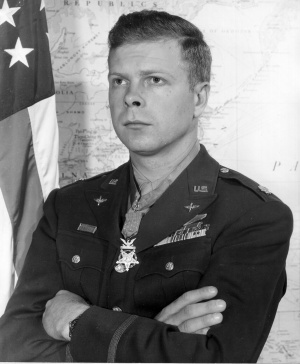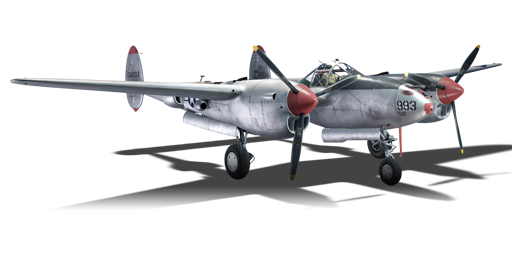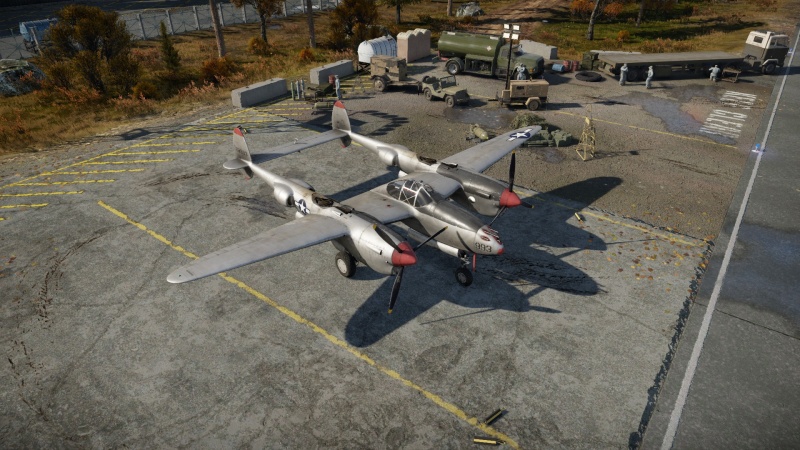Bong's P-38J-15
| This page is about the American twin-engine fighter Bong's P-38J-15. For other variants, see P-38 (Family). |
Contents
Description
Richard Bong's P-38J-15 Lightning is a premium gift rank IV American twin-engine fighter with a battle rating of 4.0 (AB/SB) and 4.3 (RB). It was available in Update 1.57 "Battle March" as a reward vehicle for the 2016 "Chronicles of World War II". The plane is painted after the camouflage scheme of American pilot Richard Bong of the US Army Air Forces, who is the highest-scoring American pilot ace with 40 kill credited in a P-38.
The P-38J is a sleekly designed, twin-engine monoplane by Lockheed. This plane has a top speed of 431 mph (694 km/h) with an airspeed warning at 460 mph (740 km/h). The weaponry installed is 1 x 20 mm AN/M2 cannon with 4 x 12.7 mm Browning machine guns. Further expanding the role, with upgrades, it can be equipped with either rockets or bombs to further allow it to conquer and dominate the battlefield, whether that be air or ground.
General info
Flight performance
| Characteristics | Max Speed (km/h at 7,921 m) |
Max altitude (metres) |
Turn time (seconds) |
Rate of climb (metres/second) |
Take-off run (metres) | |||
|---|---|---|---|---|---|---|---|---|
| AB | RB | AB | RB | AB | RB | |||
| Stock | 667 | 649 | 12192 | 22.6 | 23.4 | 15.9 | 15.9 | 332 |
| Upgraded | 720 | 693 | 20.4 | 21.5 | 24.3 | 19.6 | ||
Details
| Features | ||||
|---|---|---|---|---|
| Combat flaps | Take-off flaps | Landing flaps | Air brakes | Arrestor gear |
| ✓ | ✓ | ✓ | X | X |
| Limits | ||||||
|---|---|---|---|---|---|---|
| Wings (km/h) | Gear (km/h) | Flaps (km/h) | Max Static G | |||
| Combat | Take-off | Landing | + | - | ||
| 790 | 289 | 565 | 495 | 250 | ~9 | ~5 |
| Optimal velocities (km/h) | |||
|---|---|---|---|
| Ailerons | Rudder | Elevators | Radiator |
| < 380 | < 460 | < 500 | > 420 |
| Compressor (RB/SB) | ||
|---|---|---|
| Setting 1 | ||
| Optimal altitude | 100% Engine power | WEP Engine power |
| 7,500 m | 2,540 hp | 2,845 hp |
Survivability and armour
- 6.5 mm Steel - Fore cockpit armour plating
- 6.5 mm Steel - Pilot's seat
- 9.5 mm Steel - Pilot's headrest
- 38 mm Bulletproof glass - Windscreen
Modifications and economy
Armaments
Offensive armament
Bong's P-38J-15 is armed with:
- 1 x 20 mm AN/M2 cannon, nose-mounted (150 rpg)
- 4 x 12.7 mm M2 Browning machine guns, nose-mounted (500 rpg = 2,000 total)
Suspended armament
Bong's P-38J-15 can be outfitted with the following ordnance:
- Without load
- 2 x 500 lb AN-M64A1 bombs (1,000 lb total)
- 6 x M8 rockets
Usage in battles
When playing the P-38J climb to a high altitude, search for the enemy, locate the enemy you feel confident in engaging. Once these steps have been, ticked-off the check-list. Assuming you are above the enemy target: Put the plane into a gradual descent, which gives you and allows you to maintain the speed advantage. As you are descending; make small corrections on your path, so you don't give the element surprise away by overshooting the enemy. Now you are about one to two seconds away, from your target. Line your sights up, with your sights on the tail and fire a burst with your cannon and machine guns. You have now shot down your target. Why keeping the momentum, climb back up to the height you where before and repeat for the best results.
Ground Battles Using this plane in ground battles, is very effective once you have unlocked the appropriate modules. FMBC Mk.1 allows you to equip two x 500 lb bombs, these are mounted under the wings. To help get the bombs on target, use the machine guns to help predict where the bomb will fall. To do this, put the plane into a steep dive. As you near the ground and start getting closer, fire the machine guns. Using a short burst, if the burst hits the area or target you are aiming for; drop the bombs then pull up.
They are great for destroying, tanks, bunkers and ships. M10 Bazooka module allows you to equip your P-38J with two bazookas, each one has three rockets in total you get six rockets. These are attached to the lower nose panel, and are very accurate. These are ideal for destroying tanks and bunkers.
Once the ground units have been destroyed, you can use this to plane dominate the air and keep the enemy bomber and fighters away. This will help you secure that much wanted victory.
Manual Engine Control
| MEC elements | ||||||
|---|---|---|---|---|---|---|
| Mixer | Pitch | Radiator | Supercharger | Turbocharger | ||
| Oil | Water | Type | ||||
| Controllable | Controllable Auto control available |
Controllable Auto control available |
Controllable Auto control available |
Separate | Not controllable 1 gear |
Not controllable |
Pros and cons
Pros:
- Excellent speed, acceleration, and climb rate
- Very powerful armament, great for bomber hunting
- Armament being positioned in the nose allows it to have great and fearsome head on capability
- Multiple armament presets: Gives it a wider role it can have external Bombs or Rockets mounted
- Good roll and turn time
- Good overall visibility in simulator matches
- Great air superiority aircraft
Cons:
- Wing fuel tanks, prone to fuel tank fires when shot
- Unable to dive to put wing fires out, without breaking wings
- Easy to rip wings in dives, no air/drive breaks as installed on P-38L
- Easy to black out if crew vitality is low, i.e. G-force and stamina are low
- Low cannon ammunition amount, compared to other planes in the tier
History
The concept of the plane was made in February 1937 when the US Army Air Corps made a requirement for a plane that had twin-engine and can act as a high-altitude interceptor that can hold a large amount of armament and ammunition. The term "interceptor" was used for the aircraft by the requirement authors, 1st Lt Benjamin S. Kelsey and Gordon P. Saville, to bypass the Air Corps' strict requirements on aircraft designs at the time. The specifications laid by this new requirements also called for a maximum speed of 360 mph (580 km/h) and able to climb to 20,000 ft altitude in six minutes, making it the toughest specifications at the time. Design proposals were made for the specifications, one of which would become the Bell P-39 Airacobra, but it was the Lockheed design team headed by Hall Hibbard and Clarence "Kelly" Johnson that made the final product. They made many designs with a twin-engine configuration. The prototypes made for the design used a twin-boom design to hold all the components of the aircraft. Various armaments were tested on the aircraft, from different machine gun combinations and autocannons. It was finally settled to four M2 .50 cal machine guns and one Hispano 20 mm autocannon. The aircraft armament configurations, all at the nose of the aircraft, was very unusual for American aircraft design, as most of their designs and those of their foreign contemporaries had the armament mounted on the wings angled forward. Because of this mounting, the aircraft is able to fire at a longer distance accurately than wing-mounts.
Combat Usage
The P-38 performed very well in the Pacific and European theatres during World War II. They were used in roles such as bombers escorts, escort V.I.Ps, performing reconnaissance over enemy locations, combat air patrols, ground attack, search and rescue and other important and critical roles.
Survivors
Unfortunately, it is estimated that only five P-38Js survived to this day and of these, only two of them are still airworthy.
Richard I. Bong
Richard Ira Bong was born in Superior, Wisconsin, on 24 September 1920. He grew up on a farm in Poplar, WI, where he gained an interest in aviation while watching planes fly overhead. Bong enrolled in the Civilian Pilot Training Program (CPTP) in 1938 while attending Superior State Teachers College (now University of Wisconsin-Superior). He also took private flight lessons, and on 29 May 1941, he enlisted in the Army Air Corps (USAAC) Aviation Cadet Program.
After training in California, Bong was commissioned as a second lieutenant on 19 January 1942, when he was awarded his pilot's wings. He was assigned to Luke Field, Arizona, as a gunnery instructor from January to May 1942. His next assignment was to the 49th Fighter Squadron (FS), 14th Fighter Group at Hamilton Field, California. He was assigned to the 49th Squadron on May 6, and with that squadron he was trained to fly the Lockheed P-38 Lightning; 49th Squadron was based at Hamilton Field, CA at the time.
On 12 June 1942, Bong buzzed (flew low) over a house in San Anselmo belonging to a pilot who had just been married. Bong was cited and grounded after the incident, along with three other pilots who had looped around the Golden Gate Bridge. General George C. Kenny, commander of the Fourth Air Force, reprimanded him. Bong always maintained that he had not done so, but was forced to stay behind when the squadron was sent to England in July of 1942. He was then transferred to 84th Fighter Squadron of the 78th Fighter Group which was also based at Hamilton Field.
Bong was then sent to the Southwest Pacific area, when he was assigned to the 9th Fighter Squadron on 10 September 1942. At the time, the squadron was flying Curtiss P-40 Warhawks from Darwin, Australia. While awaiting the delivery of P-38 Lightnings, the 9th FS was transferred temporarily to the 39th Fighter Squadron, 35th Fighter Group, based in Port Moresby, New Guinea. Bong scored his first aerial victories on 27 December when he shot down a Japanese A6M "Zero" and a Ki-43 "Oscar" over Buna. For his actions during the battle of Buna-Gona, Bong was awarded the Silver Star.
In January 1943, Bong was reassigned to the 9th FS, based out of Schwimmer Field (near Port Moresby), which had by then been equipped with P-38 Lightnings. On 26 July, Bong participated in an action in which he would down four enemy aircraft over Lae. For this action he earned the Distinguished Service Cross. He was promoted to Captain in August.
During November and December, Bong was on leave in the United States. During this time, Bong met Marjorie Vattendahl and began dating her. When he returned to the southwest Pacific in January 1944, he named his P-38 "Marge" and painted a picture of her on the nose. Bong shot down his 26th and 27th aircraft on April 12, and was later promoted to major by General Kenny. Afterwards, he was sent to see General Henry "Hap" Arnold in the United States, and he was given a leave. After Bong went on a war bond promotion tour through 15 states, he returned to New Guinea in September. His assignment was to the V Fighter Command as an advanced gunnery instructor. He was allowed to fly on missions, but not to seek out any sort of combat. He flew out of Leyte during the Philippines campaign, and by 17 December 1944, he had attained a total of 40 confirmed aerial victories.
Bong considered his gunnery skills as lacking, and as such decided to fly as close to the enemy as possible before shooting. In one case he even collided with an enemy aircraft, claiming it as a probable kill.
Commander of the Far East Air Force, General Kenny, recommended for Bong to receive the Medal of Honor; it was awarded to him by General MacArthur in December of 1944. Bong was sent home permanently in January of 1945 by General Kenny. He married Marjorie Vattendahl on 10 February 1945.
Bong became a test pilot for the Lockheed Corporation's Burbank plant in California. On 6 August 1945, Bong took off in a Lockheed F-80 Shooting Star (44-85048), with a previous total of four hours and fifteen minutes - 12 flights - of flight experience in the F-80. During the takeoff, the main fuel pump failed, and Bong ejected. Unfortunately, he was too low for his parachute to deploy, and he died in the event. He was buried at Poplar Cemetery in Poplar, Wisconsin.
Notable pilots

Media
- Skins
- Videos
See also
- Aircraft of comparable role, configuration and era
External links
- Official data sheet - more details about the performance
- AAF Manual 51-127-1 - Pilot Training Manual for the Lightning P-38
| Lockheed Corporation | |
|---|---|
| Fighters | XP-38G · P-38E · P-38G-1 · P-38J-15 · Bong's P-38J-15 · P-38K · P-38L-5-LO · YP-38 |
| Bombers | B-34 · PV-2D |
| Jet Fighters | F-80A-5 · F-80C-10 |
| F-104A · F-104C | |
| Export / License | A-29 · ▄Hudson Mk V |
| ␗P-38L-1 | |
| ␗F-104A · ▀F-104G · ␗F-104G · ▄F-104G · ▅F-104J · ▄F-104S | |
| See Also | SABCA · Mitsubishi Heavy Industries · Fiat Aviation |
| USA twin-engine fighters | |
|---|---|
| P-38 | XP-38G · P-38E · P-38G-1 · P-38J-15 · Bong's P-38J-15 · P-38L-5-LO · P-38K · YP-38 |
| P-61 | P-61A-11 · P-61C-1 |
| F7F | F7F-1 · F7F-3 |
| Other | XF5F · XP-50 · F-82E |
| USA premium aircraft | |
|---|---|
| Fighters | Thach's F2A-1 · Galer's F3F-2 · F2G-1 · F4U-4B VMF-214 · P-26A-34 · Rasmussen's P-36A · P-40C · P-43A-1 |
| P-47M-1-RE · ⋠P-47M-1-RE · P-51A · P-51D-10 · P-51D-20-NA · ␠Kingcobra · XP-55 | |
| ▃A6M2 · ▃Ki-43-II · ▃Ki-61-Ib · ▃Bf 109 F-4 · ▃Fw 190 A-8 · ▃Spitfire LF Mk IXc | |
| Twin-engine fighters | XP-38G · Bong's P-38J-15 · P-38K · YP-38 · P-61A-11 · XF5F · XP-50 · F7F-3 |
| Jet fighters | P-59A · F-86F-35 · F-89B · F-89D · F-4S Phantom II · F-5C · F-20A |
| Strike aircraft | A-1H · A2D-1 · AU-1 · XA-38 · AV-8A · AV-8B (NA) · A-6E TRAM · A-10A |
| Bombers | A-26C-45DT · B-10B · BTD-1 · PBM-3 "Mariner" · PBM-5A "Mariner" · PV-2D |





